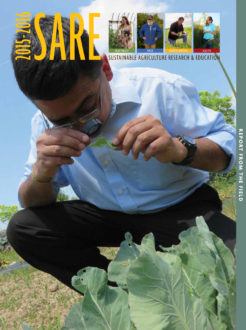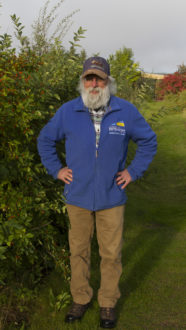The innovative projects highlighted in this report illustrate the effect of Western SARE funds in this vast and diverse region. The investment of almost $53 million over 27 years has enabled 994 project leaders to conduct high-quality research that draws on true engagement and collaboration with producers. This research has impacted such agricultural issues as efficient water use, sustainable livestock grazing, soil health and cover cropping, improved marketing and branding, and more.
Importantly, research results do not stay shelved—Western SARE is committed to getting project results into the hands of those who most need them. Researchers, ag professionals, farmers, ranchers and policymakers all have access to publications, research reports, videos and other tools detailing the work that has been conducted and how new practices can be tested in their area.
From 2014 to 2016, the number of proposals submitted in two key grants programs—Research and Education, and Graduate Student—more than doubled, indicative of the growing need for an investment in sustainable agriculture research in the Western Region (2016 data not shown). With a dedication of more funds, Western SARE would be better able to invest in more of the next “big ideas,” as it did with researcher Rick Engel (p. 9) and graduate student Felipe Barrios Masias (p. 10).
Grants Awarded in the West
The following is a summary of SARE funding in the West. State-by-state grant data is also available. To learn about SARE-funded activities and opportunities in Western states, visit our state program pages. Visit the projects database to search individual projects by type, topic, state and other criteria.
Grant Proposals and Awards, 2014-2015
| Grant Type |
Preproposals
Received1 |
Full Proposals
Invited |
Full Proposals
Received |
Proposals
Funded |
Funding
Total |
| Research and Education | 97 | 33 | 31 | 14 | $3.4 million |
| Professional Development | N/A | N/A | 55 | 14 | $842,500 |
| Farmer/Rancher | N/A | N/A | 50 | 19 | $286,707 |
| On-Farm Partnership | N/A | N/A | 58 | 14 | $662,861 |
| Graduate Student | N/A | N/A | 61 | 13 | $409,307 |
| 1 The use of a preproposal process varies by region. It serves to screen project ideas for the larger and more complex grant programs, to reduce applicants’ proposal preparation burden and the proposal review burden for SARE’s volunteer reviewers. | |||||
Total Grants Awarded in the West, 1988-2015
| Grant Type | Grants Awarded | Total Dollar Amount |
| Research and Education | 287 | $35.1 million |
| Professional Development | 154 | $9.8 million |
| Farmer/Rancher | 445 | $4.6 million |
| On-Farm Partnership | 46 | $2 million |
| Graduate Student | 62 | $1.2 million |
| Regional Total | 994 | $52.7 million |
Improving the Water-Use Efficiency of Tomatoes
A SARE Graduate Student grant helped shape a sustainable horticulture professor's career, and generated valuable information for California tomato growers who want to make more efficient use of irrigation water.
Keeping Fertilizer in the Ground and Out of the Air
In "a landmark study," Montana State University researchers teamed up with wheat farmers to develop improved recommendations for applying nitrogen fertilizer that minimize atmospheric losses. Through a few changes to application methods and timing, farmers can dramatically reduce the amount of applied N that is lost to volatilization, which improves their nutrient-use efficiency and saves them money.
USDA Improves Technical Outreach to Organic Farmers
[SARE: ADVANCING TECHNICAL SUPPORT TO ORGANIC FARMERS] At a Soil Quality Network meeting in Oregon, a participant cuts a cover crop to determine its biomass, which allows for a rough estimate of the nitrogen contribution it will make to the following crop. Photo by Rex Dufour, National Center for Appropriate Technology In 2009, the USDA Natural Resources […]

